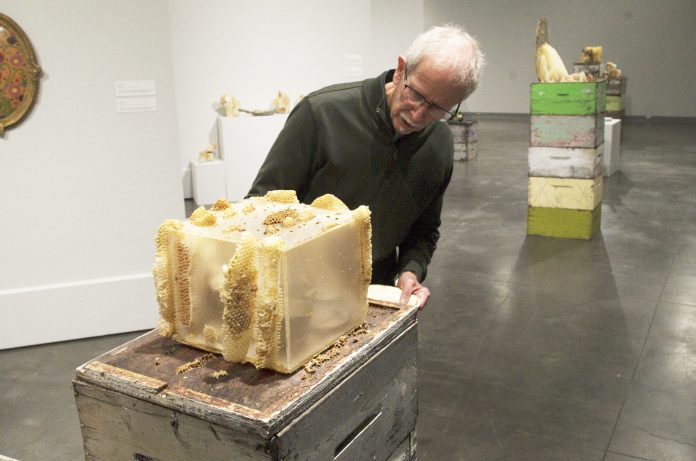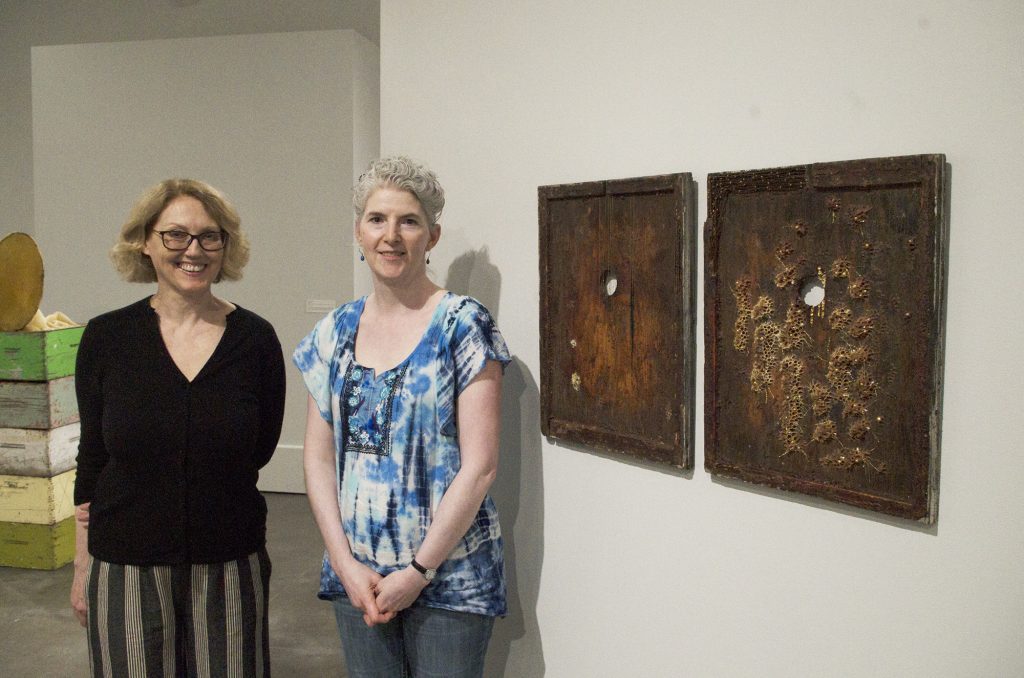
Saskatchewan honeybees are known for creating pollen, beeswax, royal jelly, and of course, honey, but now they can add ‘visual art’ to the list thanks to the latest exhibit at the Mann Art Gallery.
“Between Us” is the culmination of 12 long-term creative collaborations between artists, beekeepers, and their honeybees under the guidance of Canadian sculptor and former Prince Albert resident Aganetha Dyck. The exhibit officially opened on Friday, and participating artists said they were thrilled to see the results after an unpredictable creative relationship.
“(The challenges were) just trying to understand how to stimulate the bees to participate, to work into the pieces that we made, to anticipate that, and also to come to terms with what they did decide to do,” said Judy McNaughton, one of four Prince Albert artists who took part in the project. “Sometimes it worked on a piece and sometimes it didn’t work. That was the challenge, to kind of come to terms with that.”
McNaughton partnered with another local artist, Nicole Charlebois-Rina, for a series of pieces. The two artists had worked together before, but never on a project with bees.
McNaughton said it was an easy decision to bring in Charlebois-Rina, who operates a local commercial honeybee farm outside Prince Albert with her husband.
Like McNaughton, Charlebois-Rina said working with bees on an artistic project makes for an unpredictable process. She tried to do something similar years ago without success, but was ready to try again.
“I do understand bees, but exactly how the bees were going to work on (the pieces) was not as predictable,” Charlebois-Rina said. “I was quite arrogant in the beginning thinking that I know bees and I’m going to be able to get them to do what they want to do. Even if you encourage them, they still make their own decisions, so it was a learning process from the beekeeping end of it.”
As part of the process, Charlebois-Rina placed pieces of her own inside the hive along with some of McNaughton’s, and a few belonging to another local Prince Albert artist, Denise Flaman. She would take pictures every few days to show the other two artists how the bees transformed the objects with beeswax frills or geometric comb. The artists would then make a decision on whether to keep the pieces inside the hive, or remove them and start over.
The entire process lasted two season.
“The forms that the bees created are so astounding,” McNaughton said. “They’re so beautiful. I keep seeing modernist sculptures in them and then thinking about how modernism arose from these kind of organic forms, but the original artists are the bees.”
McNaughton and Charlebois-Rina also turned the tables for one project, taking lids used inside the hives, and adding their own drawings or paintings too them. Both artists said the bees had been reacting to their creations, and they wanted to change course and react to something the bees created.
Working with honeybees to create an art show was a unique approach both artists wanted to be a part of, but there was an even bigger driving force: the chance to learn from Aganetha Dyck.

“I was thrilled because I’m a big fan,” McNaughton said. “I love her work and the idea of learning from her and learning to work with bees and to collaborate with bees and the natural processes seemed really intriguing.”
“I was thrilled because Aganetha has not just been someone I admire, she’s one of my heroes,” Charlebois-Rina added. “I was introduced to her work when I was in university and I was intrigued by it.
“To work with her was really a great thrill. Aganetha was so encouraging and positive and just everything I had imagined.”
“Between Us” was originally conceived by Sandee Moore, the curator of exhibitions and programming at the Art Gallery of Regina. The exhibit name is an invitation for members of the public to appreciate insects like bees and the role they play in life.
Prince Albert painter, and former University of Saskatchewan sessional lecturer George Glenn was one of the first artists asked to take part. He worked with Aganetha Dyck in Prince Albert in the mid-‘70s, and was intrigued by the project.
“Everybody came with different expectations of what the bees would do and how you would get them to work in a certain kind of way,” George said. “A lot of them had very specific ideas of what the bees should do, and the bees will always work against that.”
Glenn created three lives stills, and gave them to a Regina beekeeper, who placed them inside a riser to see what the bees did with them. The first two seasons saw minimal activity, but it was enough for Moore to apply for a grant, which allowed more artists to join the project.
Finally, in the third season, Glenn’s works started to draw attention.
“The first two seasons the bees didn’t do anything, and the third they went crazy,” he said with a chuckle. “The honey, they covered all of the objects. That was pretty close to the kind of thing I had envisioned: the bees just building over everything.”
The interest in honeybees wasn’t the only thing that drew Glenn to the project. McNaughton, Flaman, Charlebois-Rina, and another local artist who participated, Tim Moore, are all former students of his.
Glenn said they were all independent students who worked at a high level.
“It doesn’t surprise me at all to see them here,” he said. “They put themselves in this spot.”
“Between Us” is on display at the Mann Art Gallery until Oct. 28. Glenn said working with bees and beekeepers brought a sense of calm. He hopes patrons will feel the same thing when they take in the exhibit.
“It’s harmonious,” he said. “They (the bees) know what they’re doing. They work hard. It’s a wonderful model for a really constructive and positive kind of living, and people who work with bees kind of take on that quietness and that calmness.
“Marcus (Mann Art Gallery curator Marcus Miller) was telling me a group of seniors came in today and they loved the show. They could really relate to it. You could put the best artwork on the wall, and it might not happen for them, but they related to this so I think that’s pretty remarkable.”

